What is the importance of emergency and priming units in the energy sector?

Everything you need to know about the importance of emergency and priming units in the energy sector
Today, all private and professional installations consume electrical energy. In case of a power failure, electric generators are a source of electrical power supply. Find out about the possible uses of these devices, their operation and how to choose the complete set necessary to prime them.
Need advice?
Our team of experts is here to help you.
You can contact us via a simple click:
Emergency generators: an essential source of electrical current
A electric generator is an emergency electrical power supply used in case of a power failure.
After climatic events or the saturation of the electrical grid, they are an essential source of energy to supply power to sensitive places and to keep the equipment running in certain industrial buildings, datacentres, banks or hospitals, etc. This type of power station can take over without an interruption of energy production and prevents, in the case of power failures, important economic loss or endangering human lives.
For outdoor use, these emergency power sources are easily transportable and are used for emergency operations. Portable manual start electric generators are used during major events, for example when there is an unexpected interruption of the public grid.
Emergency generators can also be used to produce electricity for domestic use. They can provide power to run electrical appliances during a power failure. For household use, diesel models are not very powerful, generally less than 10 kVA, and are equipped with a diesel engine. The rotary speed of the alternator, between 1500 and 3000 rpm, is much higher than that of the emergency units used to provide power to industrial systems.
The operation of an emergency generator
An electric generator is an electrical power plant. Consisting of a generator, the combustion engine creates mechanical energy derived from fuel. In inverter models, the alternator transforms it into direct current and an inverter completes the system to convert it into single-phase alternating current.
As it creates a great deal of heat during combustion, a ventilation system is added. This cools the engine to avoid damaging it or risking decreased performance or excessive consumption.
The capacity of the tank is important for professional use. The principle is to fill the large fuel tank that is necessary to start the emergency electric generator. It generally contains fuel. Indeed, although diesel engines are very noisy and cause disturbance, these generators deliver considerable wattage and have a great deal of autonomy.
For permanently installed electric generators or when they are used outdoors, manual pumping enables the circuit to be primed for start up.
The storage tank is often located at a distance from the generator. In this case, there are considerable lengths of suction hose and the electric starter pump is not sufficient.
How to choose the right set of equipment to go with your emergency power generator
To properly choose the maximum power, you must take into account the consumption delivered during operation and that necessary for starting, which differ according to the loss of load in the piping. The model of pump is chosen according to these elements that determine the requirements of combustion engines and their fuel consumption in litres per hour.
You will find all the information on the power of the unit in the device's manual.
To find the tooling required to install your diesel units, it is essential to base your choice on other precise criteria: the length of the suction and discharge hoses, their height and diameter, the presence of connecting accessories: elbows, valves, meter, filters, etc.
We recommend you provide us with the full plan of the installation to help you choose the right set to install. It should also be adapted according to your needs for energy production: Atex or not, specific footprint, need for a high flow rate, serious loss of load, etc.
Certain models run on a petrol engine – in this case, don't hesitate to consult our team for personalised advice.
